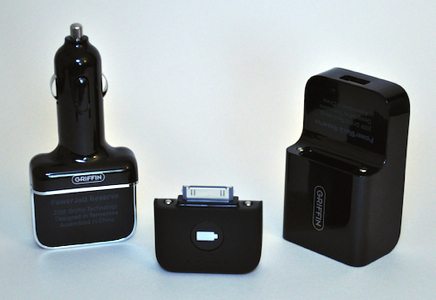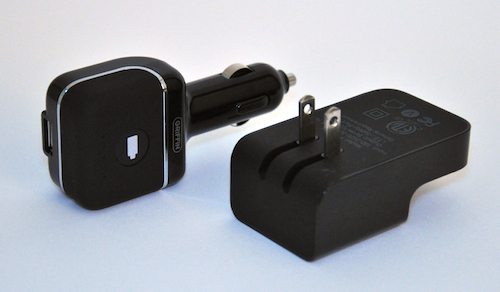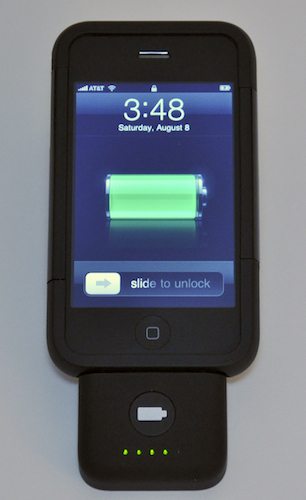
Anyone who has owned an iPhone for even a short period of time can tell you that its biggest flaw — or at least, the biggest flaw that isn’t directly related to the carrier — is its frustratingly insufficient battery life, especially compared to standard mobile phones. The typical solution for most users is to either switch off services such as Wi-Fi, 3G or Bluetooth when they aren’t being used, or to simply charge the iPhone one or more times during the course of the day. I rarely use my iPhone as an actual phone, and I still find myself running the battery down below 20% during an average day if I don’t take the time to recharge it at least once. I’m not always in a position where I can sit around and wait for my iPhone to charge, however, and that’s precisely the problem that Griffin Technology‘s PowerDuo Reserve is intended to solve.
You may recall that Griffin had previously released a car charger and a home AC charger called the PowerJolt and PowerBlock, respectively. Each of these chargers had a single standard USB port and included a USB to Apple dock connector cable allowing you to charge any of the iPod models, from the Shuffle to the iPod Touch. Griffin has now replaced these with the PowerJolt Reserve and the PowerBlock Reserve, omitting the included USB to dock connector cable and replacing it with a rechargeable battery pack.

You can purchase the PowerJolt Reserve and the PowerBlock reserve separately, or you can purchase them together as the PowerDuo Reserve. The major difference between buying the individual packages and buying the PowerDuo pack is that the latter includes only one battery pack to share between the two chargers. If you anticipate needing to keep a charged battery pack in two different places, or you simply would prefer to have two battery packs charged and ready at any time, you may want to consider buying the separate packages.
The styling of the chargers has changed pretty significantly since the previous versions, both now employing a theme of shiny black plastic and rounded right-angles that is far more in line with the Apple aesthetic. The PowerJolt Reserve features chrome trim around the area where the battery pack is docked, which not only makes it a better match for the decor of most modern automobile interiors, but it also serves to make the area more visible in a darkened vehicle. It’s a minor feature, but it makes the device just that much easier to use, and serves as a further indicator of the kind of thought that went into the design of the product.
Speaking of both small details that I love and design cues wisely borrowed from Apple, all three pieces of this kit (PowerJolt, PowerBlock, and battery pack) have a small magnet built into the housing, making charging the battery pack as simple as putting it approximately in the right place on one of the chargers. Get the pack within roughly half an inch of its home, and it jumps right into place, just like the MagSafe plugs on modern MacBooks. The amount of magnetic pull is just right, too; removing the battery pack from the charger doesn’t threaten to dislodge the charger from the wall socket or your car’s accessory plug, but it holds it well enough that the pack will stay in place through all but the most violently bumpy driving. Since the charging takes place via two metal contacts on either side of the battery pack dock connector, this also saves wear and tear on the dock connector itself, potentially extending the life of the entire system.
The battery pack itself is about an inch and a half tall (including the dock connector), and just under two inches wide, so it’s easily pocketable, roughly two-thirds the size of a Zippo lighter. The front of the pack is finished in soft-touch plastic, so it doesn’t easily scuff, is basically immune to fingerprints, and is easy to grip when plugging it into or removing it from an iPod/iPhone or one of the chargers. A single slightly-recessed button allows you to check the battery level via a set of five green indicator lights. It’s worth noting that this button doesn’t do anything if the pack isn’t plugged in; if you press the button while it’s disconnected, nothing happens. The first time I pressed the button and got no response from the battery level lights, I presumed that the battery pack was dead, and only discovered otherwise when I plugged it in again to charge. I suppose this is to prevent accidental button presses from running the battery down, but it would certainly be nice to be able to check the battery level without plugging it in to anything. The charging process seems to take a couple of hours, and the battery level lights are illuminated throughout the process to reflect the extent to which the battery has been charged. The base of the dock connector on the battery pack sticks out just a couple of millimeters from the body of the battery pack, no doubt to allow it to be used with all but the thickest of protective sleeves or cases. I keep my iPhone in one of Griffin Technology’s Clarifi cases, and the case and the battery pack don’t even make contact when the pack is plugged into my iPhone.

Of course, the most important question here is, “how much power can I get out of the battery pack?” To test this , I charged the battery pack fully and ran my iPhone down until it would no longer power on. I plugged in the battery pack until it had exhausted its power supply, and took note of both the charging time and the iPhone battery life reported by one of the many battery life apps in the App Store. In my tests, I found that the pack would charge the iPhone for 35-40 minutes before it was completely drained, and this was generally sufficient to bring the iPhone battery to just over half capacity. I did also note that the first few lights on the battery pack went out pretty quickly, and the last light seemed to last considerably longer, so the lights may not be a completely accurate measure of the amount of power remaining in the battery pack.
So is there anything that could be improved about the PowerDuo Reserve? Sure. The iPhone isn’t exactly pocketable while the battery pack is plugged into it. While you probably could physically cram the whole thing into your pocket, I would be worried about snapping the battery pack connector off inside the iPhone. Second, the dock connector on the battery pack is completely exposed while it’s not plugged into something. This hasn’t proven to be a problem in day-to-day use for me, but if a lifetime of gadget ownership has taught me anything, it’s that any nook or cranny, if not properly protected, will eventually become stuffed with pocket lint. Some kind of protective cap for the battery pack would have been nice. The size of the battery pack might also prove to be problematic for owners of certain devices. The pack is wide enough that it will block the headphone jack of both the iPod Nano and the iPod Touch, making either of those devices of limited usefulness while they charge. Finally, the omission of the USB to dock connector cable is a bit frustrating. While it’s true that most iPhone or iPod owners who have bought a charging accessory in the past probably have at least one extra cable lying around, cables are cheap, and I can’t imagine that including one would have significantly increased the price of the package. If I had lost my Apple charger and cable and bought the PowerJolt, PowerBlock, or PowerDuo Reserve to replace it, it would be pretty frustrating to get home and discover that I also needed to buy a separate cable.
Overall, Griffin Technology has put together a pretty solid set of hardware with the PowerDuo Reserve. While there are certainly other portable battery packs that provide considerably more power, no other battery pack is as easy to charge as this one. No cables to plug in, no lining up connectors, just drop it in to charge and pull it out when you need it. Furthermore, most other battery packs require their own dedicated charger, while the PowerDuo Reserve system serves as both a battery charger and iPhone/iPod charger combined. The PowerBlock Reserve has replaced my original Apple charger as my default charger both at home and for travel. If your regular iPhone use is such that you could probably survive a full day if the iPhone battery had just 50% more capacity, and if you need that extra power to be portable and rechargeable just about anywhere you are, the PowerDuo Reserve is probably just what you’re looking for. If you need far more power than the standard iPhone battery provides, though, you might want to consider one of the more capacious offerings out there.
INIU Mini Portable Charger, Small 45W PD Power Bank, 10000mAh USB C in&Out Fast Charging Pocket Size Battery Pack, Travel Essentials Powerbank for iPhone 17 16 15 14 Pro Air, Xiaomi, Samsung S24 etc
32% OffINIU Portable Charger, Smallest 22.5W 10000mAh Power Bank, USB C in/Output Fast Charging 3-Output Mini Battery Pack Charger with Phone Holder for iPhone 17 16 15 14 Air Samsung S23 Google iPad Tablet
Product Information
| Price: | $59.99 |
| Manufacturer: | Griffin Technology |
| Pros: |
|
| Cons: |
|



Gadgeteer Comment Policy - Please read before commenting
Another example of Apple hogging resources – I much prefer my Nokia, I only charge it up every other day – obviously the i is for incompetent (in battery design)
The Philadelphia Examiner has reviewed a convenient iPhone portable charger from Lenmar called the miniPowerPort that even comes in different colors: pink, orange, green, blue, white and black. It’s only 1.2 ounces, extremely small to fit easily in your purse or pocket and costs a mere $29.95 from most office/computer stores. It gives your iPhone two extra charges a day and works with any USB-powered device from cameras to laptops, music players and cell phones.
Dubbo, I’m not sure I understand what you mean by “hogging resources”. The iPhone battery is only about 1150 mAh (if my research is correct), and that it lasts a full day with that little power is actually pretty impressive, especially considering how much use my iPhone gets in a day.
When you say that “obviously the i is for incompetent (in battery design),” are you forgetting that this is the same company whose MacBook Pro laptops are achieving an industry-leading 7-8 hours per charge?
K I got question. I having a problem that the recharger pack wouldn’t let me recharge my device. but when my recharger pack dies I can still recharge from cable but not the device
By the way I can recharge my device with USB and my device is IPod 4th gen.